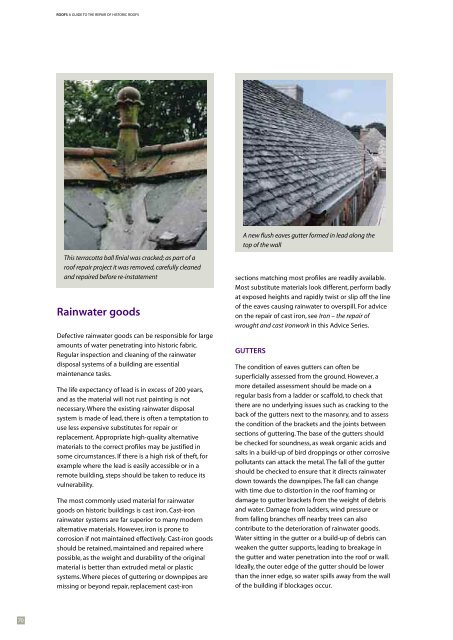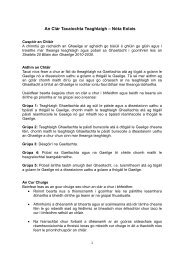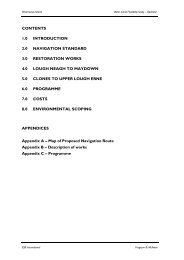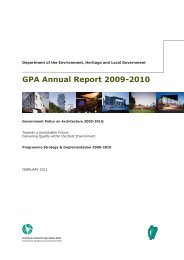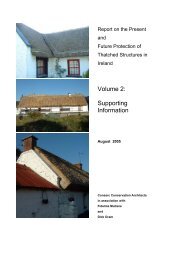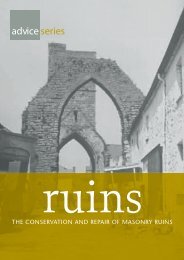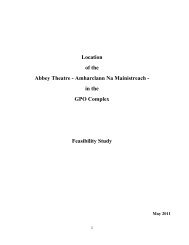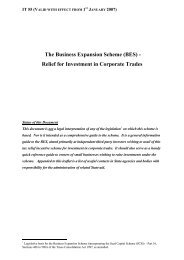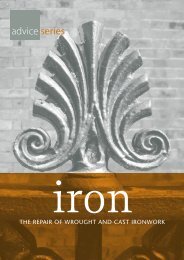A Guide to the Repair of Historic Roofs - Dublin City Council
A Guide to the Repair of Historic Roofs - Dublin City Council
A Guide to the Repair of Historic Roofs - Dublin City Council
Create successful ePaper yourself
Turn your PDF publications into a flip-book with our unique Google optimized e-Paper software.
ROOFS A GUIDE TO THE REPAIR OF HISTORIC ROOFSA new flush eaves gutter formed in lead along <strong>the</strong><strong>to</strong>p <strong>of</strong> <strong>the</strong> wallThis terracotta ball finial was cracked; as part <strong>of</strong> aro<strong>of</strong> repair project it was removed, carefully cleanedand repaired before re-instatementRainwater goodsDefective rainwater goods can be responsible for largeamounts <strong>of</strong> water penetrating in<strong>to</strong> his<strong>to</strong>ric fabric.Regular inspection and cleaning <strong>of</strong> <strong>the</strong> rainwaterdisposal systems <strong>of</strong> a building are essentialmaintenance tasks.The life expectancy <strong>of</strong> lead is in excess <strong>of</strong> 200 years,and as <strong>the</strong> material will not rust painting is notnecessary. Where <strong>the</strong> existing rainwater disposalsystem is made <strong>of</strong> lead, <strong>the</strong>re is <strong>of</strong>ten a temptation <strong>to</strong>use less expensive substitutes for repair orreplacement. Appropriate high-quality alternativematerials <strong>to</strong> <strong>the</strong> correct pr<strong>of</strong>iles may be justified insome circumstances. If <strong>the</strong>re is a high risk <strong>of</strong> <strong>the</strong>ft, forexample where <strong>the</strong> lead is easily accessible or in aremote building, steps should be taken <strong>to</strong> reduce itsvulnerability.The most commonly used material for rainwatergoods on his<strong>to</strong>ric buildings is cast iron. Cast-ironrainwater systems are far superior <strong>to</strong> many modernalternative materials. However, iron is prone <strong>to</strong>corrosion if not maintained effectively. Cast-iron goodsshould be retained, maintained and repaired wherepossible, as <strong>the</strong> weight and durability <strong>of</strong> <strong>the</strong> originalmaterial is better than extruded metal or plasticsystems. Where pieces <strong>of</strong> guttering or downpipes aremissing or beyond repair, replacement cast-ironsections matching most pr<strong>of</strong>iles are readily available.Most substitute materials look different, perform badlyat exposed heights and rapidly twist or slip <strong>of</strong>f <strong>the</strong> line<strong>of</strong> <strong>the</strong> eaves causing rainwater <strong>to</strong> overspill. For adviceon <strong>the</strong> repair <strong>of</strong> cast iron, see Iron – <strong>the</strong> repair <strong>of</strong>wrought and cast ironwork in this Advice Series.GUTTERSThe condition <strong>of</strong> eaves gutters can <strong>of</strong>ten besuperficially assessed from <strong>the</strong> ground. However, amore detailed assessment should be made on aregular basis from a ladder or scaffold, <strong>to</strong> check that<strong>the</strong>re are no underlying issues such as cracking <strong>to</strong> <strong>the</strong>back <strong>of</strong> <strong>the</strong> gutters next <strong>to</strong> <strong>the</strong> masonry, and <strong>to</strong> assess<strong>the</strong> condition <strong>of</strong> <strong>the</strong> brackets and <strong>the</strong> joints betweensections <strong>of</strong> guttering. The base <strong>of</strong> <strong>the</strong> gutters shouldbe checked for soundness, as weak organic acids andsalts in a build-up <strong>of</strong> bird droppings or o<strong>the</strong>r corrosivepollutants can attack <strong>the</strong> metal. The fall <strong>of</strong> <strong>the</strong> guttershould be checked <strong>to</strong> ensure that it directs rainwaterdown <strong>to</strong>wards <strong>the</strong> downpipes. The fall can changewith time due <strong>to</strong> dis<strong>to</strong>rtion in <strong>the</strong> ro<strong>of</strong> framing ordamage <strong>to</strong> gutter brackets from <strong>the</strong> weight <strong>of</strong> debrisand water. Damage from ladders, wind pressure orfrom falling branches <strong>of</strong>f nearby trees can alsocontribute <strong>to</strong> <strong>the</strong> deterioration <strong>of</strong> rainwater goods.Water sitting in <strong>the</strong> gutter or a build-up <strong>of</strong> debris canweaken <strong>the</strong> gutter supports, leading <strong>to</strong> breakage in<strong>the</strong> gutter and water penetration in<strong>to</strong> <strong>the</strong> ro<strong>of</strong> or wall.Ideally, <strong>the</strong> outer edge <strong>of</strong> <strong>the</strong> gutter should be lowerthan <strong>the</strong> inner edge, so water spills away from <strong>the</strong> wall<strong>of</strong> <strong>the</strong> building if blockages occur.70


